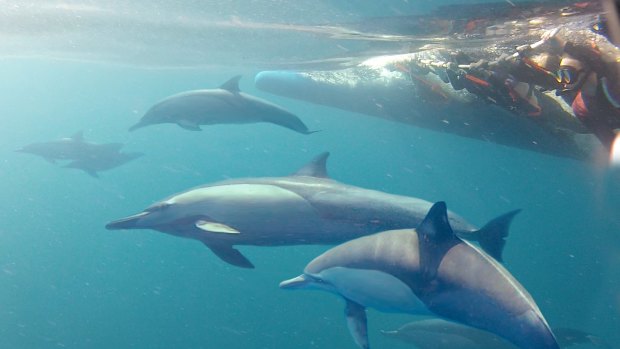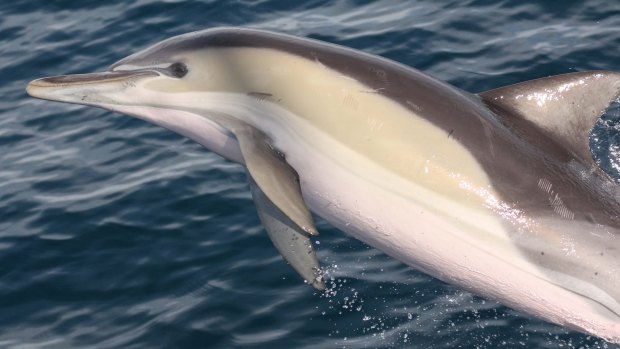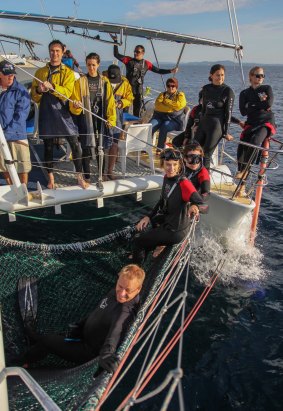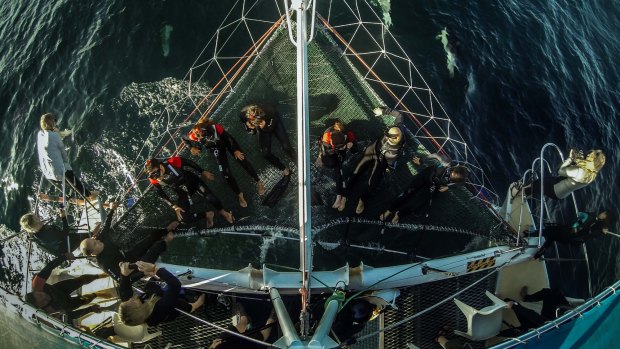This was published 9 years ago
Port Stephens, Australia: Where to swim and sing with wild dolphins

Swimming with the dolphins.Credit: Dolphin Swim Australia
Swimming with dolphins sounded like child's play, until I heard I'd be attached to a harness, clipped to a towrope and dragged face first through the water beneath a catamaran.
But first there was the net to negotiate, a bouncing cobweb stretched across the bow, from where we'd enter the water. Slung in the mesh like the day's fresh catch, hands welded to the webbing and teeth snapped like a clam on to the snorkel I wait for the call. "One, two, three. Go," shouts divemaster Adam, dropping the net and setting us free. Simultaneously, five of us plop into the heaving ocean, spin around and lunge for the rope stretched between the twin hulls of Imagine.
With a thumbs-up we are away, goggles submerged, arms stretched tight and legs flapping behind like washing on a clothesline. At first I can see only bubbles and flailing limbs, then, as we gradually settle into a rhythm, torpedos appear. Shards of sunlight penetrate the water to reveal dozens of dolphins, spinning, leaping and flying on all sides, some turning their heads to make eye contact before rocketing away.

The the unique tricolours of a shortbeaked common dolphin.Credit: Lisa Skelton
Then it hits me – I'm not swimming with dolphins, they are swimming with me.
I'm two kilometres offshore of Nelson Bay in the Port Stephens-Great Lakes Marine Park when the flash mob appears. Using echolocation and super-sonic vision, this pod of pranksters has come to see what the funny humans are up to.
While dolphins have an evolutionary history going back 50 million years, when their hoofed, wolf-like ancestors made the bold return to the sea, humans appeared relatively recently between five and seven million years ago. And our lack of grace in the water shows.

Watching and waiting.Credit: Lisa Skelton
In response to the dolphin's highly developed squeaks and creaks, a sonar system that still baffles NASA, I send out a series of "toot–toot-toots". We'd been advised to sing, but caught in the moment the only sound I muster is a honking noise, not unlike a three-year-old with a party horn. Forget the spiritual side of swimming with dolphins; this is just sheer, unbridled fun.
All too soon I'm back on deck, letting the next group prepare for their swim. In the interim, while Imagine is stopped short, a pod of 40-50 dolphins gathers around, sullen, like children when the merry-go-round has stopped. "Hurry up guys," they seem to be saying. "Get back in the water."
Our morning had begun before dawn, slipping on wetsuits in the dark and motoring out of Port Stephens harbour as the sun broke the horizon. With harnesses and snorkels fitted, a light breakfast served and safety talk out of the way we gather on deck to listen to Adam Wiltshire, divemaster and manager of Dolphin Swim Australia, talk about the short-beaked common dolphins we will be swimming with. "We think they migrate somewhere between Sydney and Byron Bay," he says, his arm sweeping across the pasture of blue.

In the net watching dolphins.Credit: Gabriel Grimison
Adam explains that these common dolphins, with their hourglass-shaped capes of grey, gold and white, are different to the all-grey Indo-Pacific bottlenose dolphins found within the bay. "The resident bottlenose dolphins, of which there are about 90 individuals, stay in the bay all year round," explains Adam, who's worked for the last two years on updating a population census while completing his Environmental Science degree.
"But no one knows much about the common dolphins in the open water," says Adam. "So far we've identified 400 individuals using cameras fitted underneath Imagine's hulls, but there are thousands of dolphins out here." It took Dolphin Swim Australia's CEO Andrew Parker four years and two applications to receive a permit from Marine Parks Authority to offer his world-first, wild dolphin swimming tours. Dolphin Swim Australia's ongoing commitment to research, conservation, education and long-term population studies is the backbone to the company's ethos.
"The idea came to me in a dream," says Parker, a qualified dive master, marine mammal observer, rescue diver and instructor. "I dreamt of helping children with autism by getting them into the water with wild dolphins."
Enlisting the help of experts such as psychologist Dr Olivia De Bergerac, author of The Dolphin Within, and Parker's mate Frank, the skipper of Imagine, Andrew began using "dolphin assisted therapy" with children who have autism, cerebral palsy, Down syndrome and cancer.
"The first time we put the kids in the water one of the mother dolphins brought her baby over to show us," says Parker. "When I saw the looks on the children's faces, I knew this was what I wanted to do."
After our first swim, Adam regales us with stories about other such dolphin encounters, such as the games they play, like passing pieces of seaweed to one another. "I've even seen a dolphin try to pass some reed to one of our swimmers," he says.
And it doesn't stop there. Time is on our side and we are hopeful of a second swim. Skipper Frank heads off in another direction, giving a wide berth to a feeding frenzy signalled by a flock of terns dive-bombing a concentrated area.
"Dolphin pods work together to drive a shoal of fish into a whirlpool," he explains. "If we disturb them we will have wasted the energy they've put into building the bait ball."
Minutes later the sky goes dark, not gradually from a storm brewing, but instantly, like someone has thrown a grey rug over the world. The wind drops and the ocean flattens, the fog pressing down, its weight an unwelcome intruder, silencing all conversation and crippling our spirits. All eyes turn to Frank as he manoeuvres Imagine through the gloom, the groan of a rope and the lapping of water the only sounds.
Finally, the sun breaks, sending great waves of light cresting over the water, light that is now bouncing off the arched backs of the carnival of dolphins heading our way. This time I negotiate the net like a trapeze artist, connect my harness and leap like a lemming on the count of three. It is child's play after all.
Kerry van der Jagt was a guest of Destination Port Stephens
TRIP NOTES
MORE INFORMATION
GETTING THERE
Port Stephens is 2.5 hours from Sydney; take the M1 freeway past Newcastle and follow signs to Nelson Bay.
STAYING THERE
The Nelson Resort is a two-minute walk to Dock C, d'Albora Marina, where the dolphin swim departs. Garden view queen rooms start from $190.00 per night. Phone (02) 4916 4600, see www.nelsonresort.com.au
SWIMMING WITH DOLPHINS
The Eco Certified tour operates Fridays to Mondays from September to May. Cost $289 per swimmer, including gear hire and a light breakfast; $60 for non-swimmers. Phone 1300 721 358, see www.dolphinswimaustralia.com.au
Sign up for the Traveller Deals newsletter
Get exclusive travel deals delivered straight to your inbox. Sign up now.